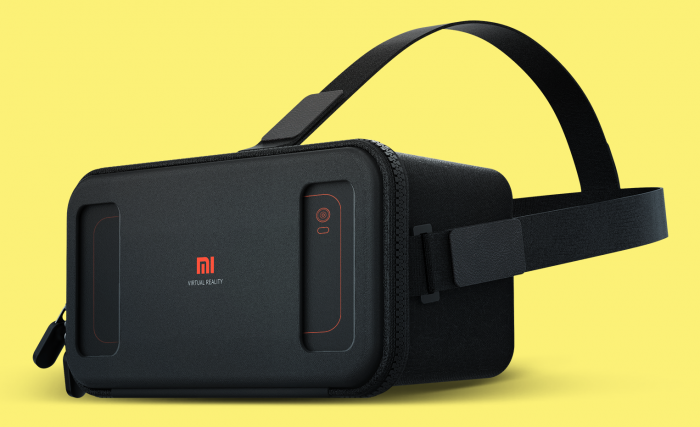China’s Xiaomi Unveils Its Answer to VR for the Masses
Chinese mobile giant Xiaomi has revealed its first virtual-reality headset, and like the rest of the company’s products, it’s built to appeal to a wide audience.
The Mi VR Play uses 4.7- to 5.7-inch smartphones as its screen and computer, which keeps manufacturing costs down and allows it to also be used as a mobile device. It’s not clear yet how users can interact with the headset once it is on their head, prompting IDC gaming analyst Lewis Ward to put it in the same category as the $15 Google Cardboard. It could also be compared to headsets such as Samsung’s $99 Gear VR or the countless knockoffs that can be had for less than $20. Mobile VR headsets are little more than a strap, lenses, and a frame.
For much of the world, the first exposure to virtual reality is likely to come from an inexpensive mobile headset. High-quality VR systems such as the Oculus Rift and HTC Vive have much better screens and can run more intensive software, but they must be plugged into a gaming computer at all times. For those who aren’t ready to invest in a headset that costs upward of $500 and a powerful PC, a mobile headset represents an alternative.
But it’s too early to tell if the simple VR headsets will have a long shelf life. “The user interface is so simplistic that my concern about this is: is it going to be functional for a wide enough variety of applications and experiences to be a long-term phenomenon?” says Ward.

Xiaomi is known in China for its inexpensive electronics, including smartphones and laptops that often bear a strong resemblance to Apple products. It held 15.2 percent of the Chinese smartphone market in 2015—the highest in the country.
Xiaomi will attempt to set itself apart from its competitors with an app store. The Mi VR app currently contains content from Condé Nast Traveler, Chinese video website YouKu, and Korean VR company Dooribun, with more experiences planned. The design of the app store looks promising, but content is what will drive adoption. Xiaomi’s phones and other Android devices are expected to be compatible with Google’s upcoming Daydream, a combination of software, sensors, and displays that will make phones specially equipped for VR.
Given that the Play is meant to be a mass-market device, it also makes sense that Xiaomi is integrating some customization options. The headset has a soft Lycra cover that zips closed to hold a phone in place. Pictures depict the cover in red floral, camo, and even denim patterns that are much friendlier-looking than its rivals’ black-and-white plastic bodies. They are loud but welcome designs that move VR away from sci-fi technology and make it seem more like a lifestyle product.
Xiaomi has not yet said what the Mi VR Play will cost but will soon launch the headset among beta testers who signed up earlier this week. The first testers will pay just 15 cents for the device.
Xiaomi’s U.S. store offers basic accessories like headphones and power banks, but it wasn’t until this spring that it announced the U.S. sale of an actual device: a set-top box revealed at Google I/O.
It isn’t clear when Xiaomi will expand its U.S. offerings. In June, the company purchased 1,500 patents from Microsoft in exchange for agreeing to ship devices with Microsoft apps installed. Those patents could help pave the way for a U.S. Xiaomi VR and phone launch.
Given how many cheap alternatives to Play are available in the U.S., Xiaomi would face some stiff competition stateside. U.S. companies are more likely to worry about competing with it in China, where Xiaomi is such a dominant name. But it’s more about exposure this early in the VR industry, anyway. More inexpensive headsets means more people noticing VR for the first time.
Ward expects the industry to quickly move past simple headsets, with Daydream being the indication that even Google is done with Cardboard-like devices.
“My question is, are Xiaomi and others willing to move in that direction quickly also?” Ward says. “This is a stop-gap product that is not where these companies will be a couple years from now.”
Keep Reading
Most Popular
Large language models can do jaw-dropping things. But nobody knows exactly why.
And that's a problem. Figuring it out is one of the biggest scientific puzzles of our time and a crucial step towards controlling more powerful future models.
How scientists traced a mysterious covid case back to six toilets
When wastewater surveillance turns into a hunt for a single infected individual, the ethics get tricky.
The problem with plug-in hybrids? Their drivers.
Plug-in hybrids are often sold as a transition to EVs, but new data from Europe shows we’re still underestimating the emissions they produce.
Google DeepMind’s new generative model makes Super Mario–like games from scratch
Genie learns how to control games by watching hours and hours of video. It could help train next-gen robots too.
Stay connected
Get the latest updates from
MIT Technology Review
Discover special offers, top stories, upcoming events, and more.